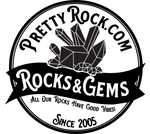Refractometer Instructions


A refractometer measures the angle at which light rays refract (or bend) as they move through a gemstone. The measurement (R.I. or Refractive Index) is read from a scale seen though the eyepiece of the refractometer. The R.I. is used to help identify gemstones. However, it cannot distinguish between natural and synthetic stones. It is used most easily with stones that have at least one flat, polished surface. Most refractometers can read to 1.82. They are limited by the R.I. of the hemicylinder and contact liquid. Stones with a higher R.I. than the hemicylinder or liquid are called OTL (over the limits.) Diamond, some diamond imitations, and certain varieties of garnet are example of OTL stones. Whole books are devoted to the use of refractomers and refractive index in gemstones. The instructions below will get you started with the basics. To use a refractometer, you need both the instrument itself and a bottle of contact liquid (also call R.I. liquid.)
- Step 1: The first time you use your refractometer, insert batteries face up into battery case. Tightly close battery cover over batteries for good connection. Press power switch to turn on refractometer. Instructions for the refractometer type shown above, yours may vary slightly.
- Step 2: Open upper cover and examine hemicylinder. The hemicylinder should be clear of any dust or film from previous use. If hemicylinder needs to be cleaned, use a little water and a soft cloth. Caution! Dried R.I. liquid can scratch the hemicylinder. If there is dried R.I. liquid on the hemicylinder, use a drop of R.I. to re-wet and dissolve any crystals that may have formed before cleaning. Hemicylinders are delicate, use care when placing or removing stones.
- Step 3: Examine the stone to be tested under a bright light. Choose the facet with the best polish and largest surface. This is usually the table of the stone. Be sure the stone is clean, wipe with a soft, lint free cloth to remove any fingerprints or dirt.
-
Step 4: Place a small (very small) drop of R.I. liquid on the upper end of the hemicylinder. Knowing how much RI to use takes some practice. You need just enough R.I. to create a good seal between the gem and the hemicylinder. As you test more stones you will learn how much R.I. is needed for the size of the stone.
Caution: Be careful not let the liquid come in contact with your skin and always replace the cap immediately to avoid spills. R.I. liquid contains harsh chemicals such as methylene iodide and sulphur. If you get it on your skin, wash immediatly with warm soapy water. For extra precaution, you can use the eraser of a pencil to pull your stone into place. - Step 5: Place the facet of the stone you have chosen to test on the R.I. liquid drop and gently pull it to the center of the hemicylinder. Close upper cover if stone is small enough. For very large stones, leave cover open.
-
Step 6: Look into eyepiece from about 4-6 inches away so that you can see the scale inside the refractometer. With practice, you will find the right spot to use for your eyes. You may have to hold your head closer or further away from eye piece depending on the stone and your eye sight.

- Step 7: Slightly move your head, up and down, side to side, and closer and further away from the refractometer until you see either blue-green flash line or a strong delineation between dark and light areas. (If you feel like a snake charmer, you are doing it right!) On bright, clear, clean, well-polished stones, the line can be very sharp. For other stones, it is very faint or you may not see at all. On stones that don’t have a good polish or flat surface, you may not be able to get a reading. If the scale appears dark all the way down to the bottom of the scale, then the stone’s refractive index is too high to read or you have used too much R.I. liquid.
- Step 8: Read the R.I. from the higher edge of the line. R.I. is read to the nearest hundredth place (example 1.65) Compare your finding with a Refractive Index Chart. There is one you can use near the bottom of this page.
- Step 9: When you are finished using your refractometer, carefully remove the stone, and clean off the hemicylinder with a soft clean cloth. Do not let the contact liquid dry on the hemicylinder. Store refractometer in its case in safe location. R.I. liquid should be stored away from light and small children. Be sure to wash your hands.
-
Determining Bifringence (Double Refraction)
- While you have a clear reading on a stone following the above directions, unscrew the polarizing filter and place onto the eyepiece.
- Rotate the polarizing filter 90° to see how much, if at all, the R.I. reading changes. Write down the RI readings.
- Rotate the stone about 45° and then rotate the polarizing filter again. Again, write down your readings. Continue rotating the stone 45° until you have 4 sets of readings. If your stone is doubly refractive, your readings might look like this:
1.770 - 1.774, 1.769 - 1.775, 1.770 - 1.774, 1.769 - 1.774 - Subtract the highest and lowest of all of your readings. (E.g. Highest 1.775 - lowest 1.769= birefringence .006)
- Compare your findings to a Refractive Index Chart that has birefringence listed.

